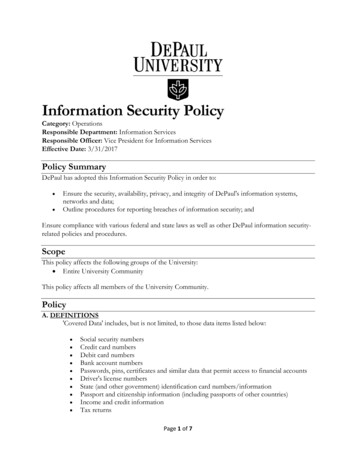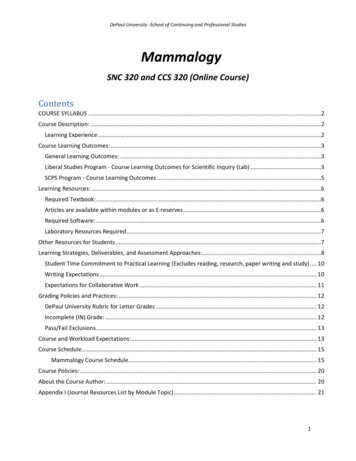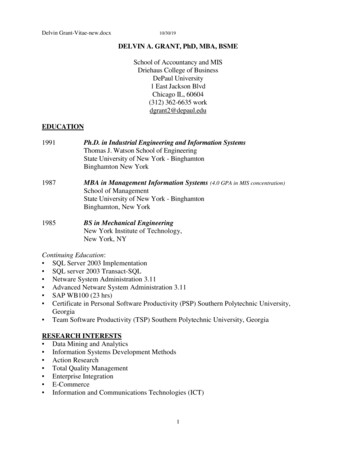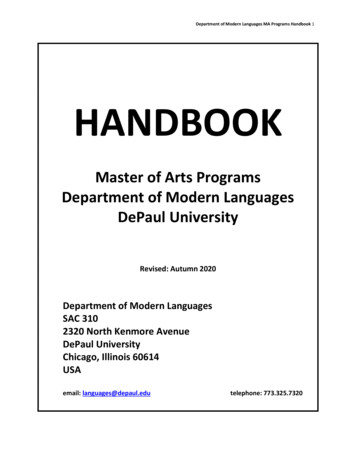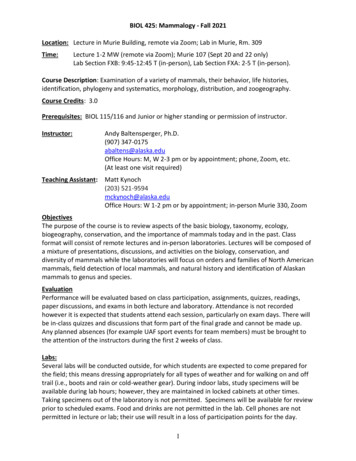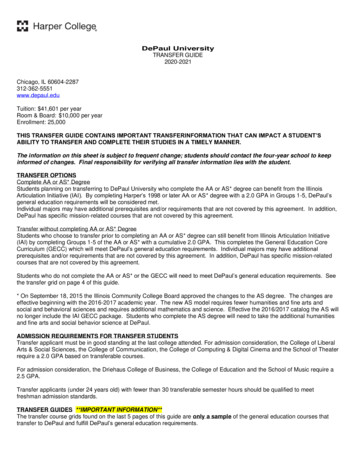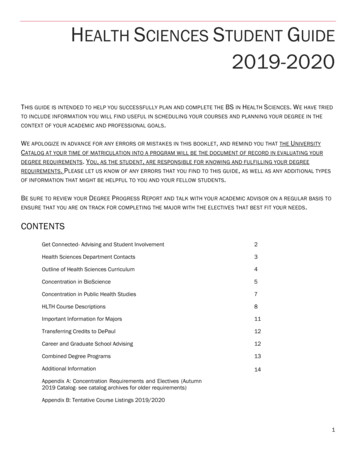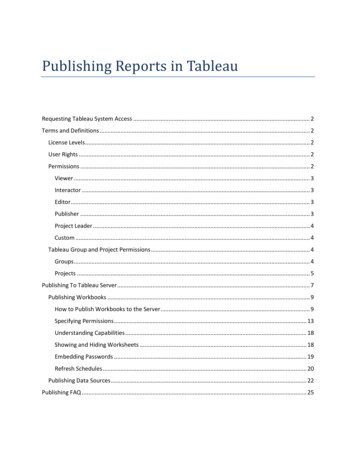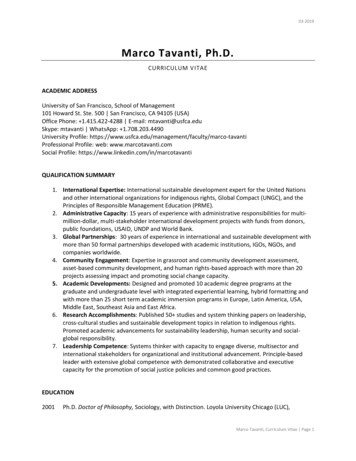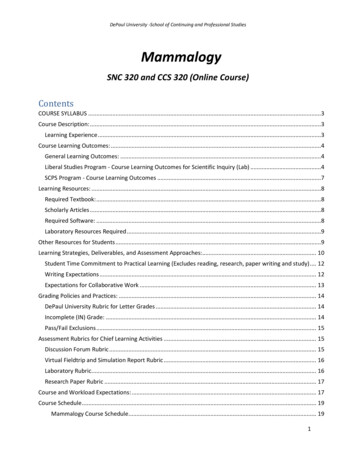
Transcription
DePaul University -School of Continuing and Professional StudiesMammalogySNC 320 and CCS 320 (Online Course)ContentsCOURSE SYLLABUS .3Course Description: .3Learning Experience .3Course Learning Outcomes: .4General Learning Outcomes: .4Liberal Studies Program - Course Learning Outcomes for Scientific Inquiry (Lab) .4SCPS Program - Course Learning Outcomes .7Learning Resources: .8Required Textbook: .8Scholarly Articles .8Required Software: .8Laboratory Resources Required .9Other Resources for Students .9Learning Strategies, Deliverables, and Assessment Approaches:. 10Student Time Commitment to Practical Learning (Excludes reading, research, paper writing and study) . 12Writing Expectations . 12Expectations for Collaborative Work . 13Grading Policies and Practices: . 14DePaul University Rubric for Letter Grades . 14Incomplete (IN) Grade: . 14Pass/Fail Exclusions . 15Assessment Rubrics for Chief Learning Activities . 15Discussion Forum Rubric . 15Virtual Fieldtrip and Simulation Report Rubric . 16Laboratory Rubric. 16Research Paper Rubric . 17Course and Workload Expectations: . 17Course Schedule . 19Mammalogy Course Schedule. 191
DePaul University -School of Continuing and Professional StudiesCourse Policies: . 24DePaul University Resources for Students:. 24Student Resources . 24About the Course Author: . 24Appendix I (Journal Resources List by Module Topic). 252
DePaul University -School of Continuing and Professional StudiesMammalogySNC 320 and CCS 320 (Online Course)COURSE SYLLABUSVersion: Winter 2022Kevin F. Downing Ph.D.AUTHOR[ 2020 -2022 , All Rights Reserved by the Author. Printed in theU.S.A.]Course Description:This course will introduce you to the origins, evolution, ecology, and biodiversity of the classMammalia. Key topics will include mammalian anatomy, classification, genetics, reproduction,thermoregulation, locomotion, behavior, ecology, and conservation. Special emphasis will be on investigatingthe connections of mammalian evolutionary biology to human health issues including disease, nutrition,physical activity, injury, and overpopulation. Online learning will incorporate readings, discussions, a science‘kit’ for hands-on labs, virtual labs using 3D mammals, and computer simulations. Student will also undertakecollaborative experimentation and onsite inquiry of mammals at a zoological park, museum, and/or naturereserve. Prerequisite: None.Learning ExperienceThis course is online asynchronous and progresses through 10 Mammalogy -themed modules that employreadings (text and scholarly articles) and multimedia resources (online videos and multimedia). Students arenot required to meet at a specified time as a class, however the instructor provides optional synchronousconsultations particularly in support of lab activities. The instructor provides weekly and other intermittentnews communications to the class around upcoming assignments and learning activities. The instructorprovides students with weekly assessments of their ongoing work and this communication serves as a highfrequency engagement between instructor and student. Student assessment includes guidance on theresubmission of assignments for more points and to increase competence in the subject matter. Additionalcourse guidance is provided by the instructor through individualized zoom sessions upon request.Students are required to participate and engage with classmates in weekly online discussion boards thatexplore and reinforce module concepts and critical thinking through original contributions and collaborativeresponses. For the collaborative group lab, peers communicate with their lab partners synchronously throughzoom or other platforms. The culminating group lab project centers on a formulated Mammalogy hypothesisat a zoological park, natural history museum, or nature reserve. This project includes a presentation to the3
DePaul University -School of Continuing and Professional Studiesclass as a whole including feedback from peers. Labs are submitted using a conventional lab form. Studentsalso complete a short original inquiry research paper following a scientific format.The course uses short video lecture clips to introduce key module concepts and lab procedures. Laboratoryexercises employ virtual mammal specimens, animal dissection simulations, 3D human and other mammalskeletal models, zoological park mammals and/or museum specimens, and online Mammalogy databases.Certain labs are collaborative requiring students to collect data and contribute to the broader analysis of theexperimental results. Laboratory experiments alternate with virtual fieldtrips every other Module.Course Learning Outcomes:General Learning Outcomes:Upon successful completion of this course, all students are expected to have demonstrated thefollowing abilities: Can analyze and apply information generated from scientific investigations in Mammalogy.Can describe, differentiate, and explain form, function, and variation within mammallineages.Can evaluate the role of mammal evolutionary history on human health.Can compare and contrast aspects of mammal behavior and ecology.Liberal Studies Program - Course Learning Outcomes for Scientific Inquiry (Lab)CategoryScientific Inquiry-Laboratory (SI-Lab) coursesStudents will understand how science servesas a mechanism for inquiry into the naturalworld through hands‐on, experience‐basedinvestigation.Learning OutcomeStudents will be able to:A. Pose meaningful scientific questionsand generate testable scientifichypotheses.B. Plan, design, and conduct scientificinvestigations in a collaborativeenvironment using appropriatetools and techniques to gatherrelevant data in order to test andrevise scientific hypotheses.C. Develop and use scientific models(conceptual, physical, andmathematical) to make predictionsand develop explanations of naturalphenomena.D. Address variability in the data andrecognize and analyze alternativeexplanations and predictions.4
DePaul University -School of Continuing and Professional StudiesE. Communicate scientific procedures,results, and explanations and engage inarguments based on scientific evidence.5
DePaul University -School of Continuing and Professional StudiesHow this course nurtures the Scientific Inquiry (Lab) y (SILab) coursesStudents willunderstandhow scienceserves as amechanism forinquiry into thenatural worldthrough hands‐on, experience‐basedinvestigation.Demonstrationa. Students will have multiple entry points to posing scientific questions andtesting scientific hypotheses connected to mammal natural history. For theresearch paper assignment, students will identify a plausible researchquestion/hypothesis through examination of current scholarly literature.They obtain and analyze their data on the self-selected mammal issue via theliterature. In virtual fieldtrips (VF) students will pose original hypothesesabout human embryology, niche partitioning, and crossbreeding. Finally, inthe 6 Labs conducted in the course, students will form and test hypothesesas an individual (L2-6), a group (L6), and with the entire class (L1).b. Mammalogy incorporates 6 lab exercises on the key topics of identification,anatomy, brain and skull development, bipedality, and ecology. For each ofthe labs students determine and apply an appropriate methodology to addressquestions, collect data, and analyze results with regard to falsification orsupport of a hypothesis and to indicate their study’s caveats and conclusions.Where students are in a group, the team first discusses the lab objective(s) andthe best approach using the general techniques andtools/specimens/databases provided. Examples of potential hypothesesexamined in labs include whether modern small mammal anatomy parallelsearly fossil mammal anatomy, whether human brain development has madeus more inclined for Alzheimer’s disease, whether bipedality is responsible forhuman spine, hip and leg issues, whether mammal distributions in GorongosaNational Park can be predicted based on seasonal food change and so on.c. The science of mammalogy uses a number of scientific models includingthose related to the evolution of the group (e.g., ear development,molarization, encephalization, thermoregulation, reproduction, bipedality)as well as biomechanical models for mammal locomotion and others toexplain disease such as Alzheimer’s. Students will use these models to buildunderstanding of mammal natural history and its connection to humanhealth. In addition, they will employ measurements and basic statisticalprocedures using excel in select labs (basic linear regression and correlationto help reach conclusions. They will choose their own model(s), as a group,to conduct Lab 6.d. Mammal natural history and its interpretation constantly evolves asscientists use emerging techniques and technologies to gather and analyzeinformation. Students in Mammalogy will regularly observe uncertainties intheir observations such as whether they made a precise and accuratemeasurement of a specimen, identified a biological feature properly, acquiredand tabulated the correct count of organisms spatially. As they workindividually on repeated procedures such as owl pellets analysis, they will gainan appreciation of biological variation. Likewise, in their group projectsstudents will gain an appreciation that the observations and data collected byothers is not identical to theirs. This will require that they consider and reviseinterpretations as warranted.6
DePaul University -School of Continuing and Professional Studiese. Students communicate their research and experimentation following ascience journal format that includes the sections: abstract, introduction,literature review/statement of problem, methods, results, discussion,conclusion and references. The format of these learning activities necessitatesthat students make the crucial distinction between results and theirsubsequent interpretation and conclusions drawn from results. Likewise, theformat for laboratory reports follows an exacting format: Title, Date, LabPartners, Purpose, Introduction, Materials, Procedure, Data, Results,Conclusion and References. For Lab 6, the culminating group collaborative labexperience, students will co-present their experiment to all classmates using atypical conference presentation format.SCPS Program - Course Learning OutcomesFOR CREDIT‐HOUR BASED DEGREE PROGRAMS (BAPS-Business Admin; BAPS-Computing; BA-HealthcareAdmin; DCM etc.)Students will accomplish the general learning outcomes for the course as well as the LSP andoutcomes described above.FOR COMPETENCE‐BASED DEGREE PROGRAMS IN SCPSThe following SCPS competencies are offered through the Mammalogy tatementCompetenceStatementS‐1‐X Can use public or private institutions or natural areas as resources forlearning science.S‐2‐X Can describe, differentiate, and explain form, function, and variationwithin a mammal.S‐3‐X Can use scientific knowledge to understand varying perspectives on amammal conservation issue.S‐4 Can describe and explain connections among diverse aspects ofnature.Students demonstrate this competence by connecting mammal evolution tohuman healthS‐5 Can explain and evaluate the nature and process of science.Students demonstrate this competence by employing scientific reasoning duringlab activities which require testing hypotheses.7
DePaul University -School of Continuing and Professional StudiesLearning Resources:Required Textbook:Clutton-Brock, J., & Wilson, D. E. (2002). Smithsonian handbook: mammals.Paperback: 400 pagesPublisher: DK ADULT; 1st edition (March 1, 2002)Language: EnglishISBN-10: 0789484048ISBN-13: 978-0789484048Product Dimensions: 6 x 1 x 8.5 inchesBook(s) available at https://depaul.bncollege.com/ or through discount outlets (Amazon, Abe’s etc.)Scholarly Articles are available within modules or as E‐reserves listed in Syllabus Appendix (below) andavailable e-Reserves-Services.aspxRecommended resource (not required):Vaughan, T. A., J. N. Ryan, and N. J. Czaplewski.2015. mammalogy. 6th ed. Jones & Bartlett,Burlington, Massachusetts, 755 pp. ISBN 978-1-284-03209-3Required Software: Excel and PowerPoint JR Screen Ruler (or similar) http://www.spadixbd.com/freetools/index.htm On Screen Protractor (or similar) https://sourceforge.net/projects/osprotractor/8
DePaul University -School of Continuing and Professional StudiesLaboratory Resources RequiredOwl PelletsOwl Pellet Kit(or direct from Oregon Owl Pellets)Frog Dissection Simulations:Frog DissectionFrog Dissection XVirtual frog DissectionBrain ModelBrain ModelHuman 3D Skeletal ModelKinebodyAccess to local Zoo, Museum and/or Natural AreaVideo (embedded in course, no purchase required):Attenborough, D. (Director). (2013). David Attenborough’s rise of animals: Triumph of the vertebrates– Episode 2: Rise of Mammals.Other Resources for StudentsInstitutionsLincoln Park Zoo Mammalshttps://www.lpzoo.org/animals/mammalsField Museum Mammal .org/list?f%5B0%5D ss org/science/research/area/mammalsCommunityAmerican Society of -american-society-of-mammalogists/viewAnimal Diversity Webb alia/Course Website: The Mammalogy course guide, course learning materials, discussion forums, andadditional resource links including supplementary videos are available through the coursemanagement system, D2LTM.Writing Resources. DePaul offers a comprehensive suite of services for students to assist in their writingactivities through the University Center for Writing-based Learning (UCWbL). In particular, students mayrequest an appointment with Writing Tutors to get detailed feedback regarding an assignment such as theirresearch paper. Another fine resource is The Purdue Online Writing Lab.9
DePaul University -School of Continuing and Professional StudiesLearning Strategies, Deliverables, and Assessment Approaches:Students will be assessed through a variety of approaches in Mammalogy including online discussions, labreports, a research paper, and virtual fieldtrip reports.Discussions. (100 points). Each module of the course has its own discussion forum for a total of 10.Discussion forum questions are formulated by the instructor to motivate student interaction andreflection around that week’s topics. Discussions build on readings, hypotheses, data, andmultimedia considered that week. An excellent response is considered 1) accurate, 2) original, 3)relevant, 4) teaches classmates something, 5) clearly incorporates information from the readingsand/or other learning materials, and 6) is well written. Excellent responses add substantialteaching/learning presence to a course and stimulate additional thought about the topic underdiscussion.Regular Lab Reports. (400 points total; 80 points each). For half of the modules of the course, studentsundertake lab activities structured to reinforce mammalogy principles and scientific reasoning. Theregular labs are generally conducted over a two-week interval.Lab 1-Mammal Identification: students analyze the kinds and numbers of small mammal specimensfrom an owl pellet kit to sharpen observation and categorization skills as well as learn to identifyand assign to species basic mammal skeletal elements. Students contrast their specimens to anearly fossil mammal. Individual students contribute their data to the class as a whole.Lab 2- Mammal Anatomy: students ‘dissect’ virtual frog models to contrast them with a virtualdissection of a rat; taking measurements as helpful and comparing the arrangement and variationof organs of the two groups. Students employ models of mammal development and evolution toassess anatomical variations and test a biological evolution hypothesis.Lab 3- Mammal Brain and Skull Development: students develop and test a hypothesis about thedevelopment of the primate brain by contrasting a scale model of the human brain to a databaseon mammal brains. Observations on photographic representations of brains in the database to testwhether the size and positions of features show evolutionary patterns. In addition, studentscontrast their brain observations to the details about human brains with Alzheimer’s disease testinga hypothesis of whether other mammals should have a lower incidence of the disease. Finally,students consider primate skull and brain development in relation to the fossil hominins.Lab 4- Mammal Locomotion -Bipedality: students test biomechanical hypotheses on whether humanbipedality is connected to health issues involving the spine, hips and legs. They undertake thisinvestigation using a 3D skeletal model of a human, conducting measurements and observations offeatures, and contrasting these to a corresponding 3D representation of the entire skeletalanatomy of a quadruped (canid).Lab 5- Mammal Ecology: students investigate their own ecological questions regarding mammalbiogeography in relation to habitat variables such as habitat, climate, and time of day by using datacollected by real-time trail cameras in Gorongosa National Park in Mozambique.Group Collaborative Lab Experiment Report. (200 points)Lab 6- Group-Determined Issue/Problem: Students research and collaborate to formulate anexperiment that they can conduct at a Zoological Park, Natural History Museum, or Natural Area. Inconsultation with the instructor they formulate a hypothesis, design a methodology, cooperativelycollect data from the institution, analyze results, and develop a joint report for submission (byModule 10). In the final week of the course they present their findings to classmates by way of azoom conference.10
DePaul University -School of Continuing and Professional StudiesStandard Lab Format and ResourcesTitle, Date, Lab Partners, Purpose, Introduction, Materials, Procedure, Data, Results, Conclusion andReferencesSupplementary Resources on Science Report Writing:Lab Report GuideWriting a Biology LabHow to Conduct a /Conduct-a-Science-ExperimentGroup Collaborative Experiment Presentation (50 points)Students will jointly prepare and present their experiment in a 12-15-minute conference modality(either narrated PowerPoint or Zoom recorded. The format for the presentation should parallel thestructure of a lab report. (See detailed instructions at the course site)Virtual Field Trip Reports. (150 points; 30 points each). Students are required to review, evaluate, andreflect on videos, simulations and other multimedia that reinforce module topics. An excellent summaryhas the following qualities: 1) a summary of the key concepts presented, 2) specific examples (e.g.,fossils, mammal species, habitats, etc.), 3) a depiction of data generated as applicable, and 3) astatement of how this learning helped in gaining a better understanding of the module topic as well asobserved weaknesses in the presentation, and 4) the summary is well written.Research Paper Final Draft. (100 points). Students are provided detailed guidelines for writing ascientifically formatted short research paper. Papers are 6 pages long, must use 3 scholarly sources andcannot exceed 1200 words. See the course site for details. Early in the course they are required tosubmit their research question, hypothesis, and approach whereas their final draft is due near the endof the course. Papers center on a student-selected mammal group. An excellent research paper has thefollowing qualities: 1) the research question is original and relevant; 2) paper adheres to the requiredscientific format; 3) resources are scholarly and relevant; 4) scholarly information is integrated andsynthesized; 5) citations are of proper format and used consistently; 6) information is evaluatedreasonably and critically; 7) corresponding conclusions are consistent with preceding information.Summary of Assignments, Point Values, and PercentagesGrading Category:DiscussionsRegular Lab ReportsGroup Lab ReportsGroup LabPresentationResearch Paper (Final)Virtual FieldtripReportsTotalNumber ofAssignmentsPointValueEachTotal Point Value% of Final %53015015%1000 Points100%11
DePaul University -School of Continuing and Professional StudiesStudent Time Commitment to Practical Learning (Excludes reading, research, paper writing and study)LaboratoriesLab 1-MammalIdentificationLab 2- MammalAnatomyLab 3- MammalBrain and SkullDevelopmentLab 4- MammalBipedalityLab 5- MammalEcologyLab 6- GroupDeterminedMammalHypothesis:Seat TimeMinimum Expected Time AllotmentIncludes preparation, conducting lab, notetaking,developing formal report, and sharing and analyzingdata with class as applicable.3 Hours3 Hours3 Hours3 Hours3 Hours5 Hours(Includes a 1-hour organizing meeting as well as sitevisit, conducting experiment, notetaking, analysis anddeveloping formal group report.)Subtotal20 HoursDiscussions0.5 hours each X 10(Includes review of other student responses and anoriginal contribution)5 HoursVirtual Fieldtrips1.0 hour each X 5(Includes conducting simulation and/or review ofmultimedia)5 HoursGroup Presentation3.0 hours(Includes group presentation and listening to andassessing other groups)3 HoursTotal33 HoursWriting ExpectationsTo assess student learning, the Mammalogy course incorporates several forms of writing assignmentsincluding laboratory reports (6), a research paper following a scientific journal format, virtual fieldtripsummaries (5), weekly online discussions, and a group presentation of the collaborative experiment. Thelaboratory reports incorporate worksheets that serve as the general template to collect and analyze dataand a summary/conclusion section in essay format. The required research paper follows a science journalformat and has a length of 1,200 words. Five virtual field trip summaries at 250 words each are submittedon a standardized form centering on case examples and student reflection. Finally, students’ weeklydiscussions conducted online require original written contributions based upon course materials as well12
DePaul University -School of Continuing and Professional Studiesas collegial responses with other students around their submissions.Each writing assignment type above has a detailed set of instructions and assessment rubric which isprovided to students in the Mammalogy course guide. All writing assignments are expected toconform to basic college-level standards of mechanics and presentation.Expectations for Collaborative WorkFor Groups Labs:Preparation: Each student should be prepared to conduct the lab activity by reviewing supportinginstructions, examples, and materials.Conducting Experiments: Each student will actively and evenly contribute to accomplishing the labprocedures and data collection. Delegation of work will be discussed and agreed upon before the labcommences. Work will be conducted under a framework of mutual respect acknowledging the importance ofcooperation to the success of the team’s experiment.Analysis and Dissemination: Team members will discuss their experimental results including possible sourcesof error. Likewise, they will review strategies to analyze data to evaluate the experimental hypothesis. Teammembers will be individually responsible for conveying lab data, results, analysis and conclusions on theprovided lab worksheets and submitting them to the grading area. Where requested, the team will deliberatethe experimental findings and disseminate unified conclusions to the class as a whole.13
DePaul University -School of Continuing and Professional StudiesGrading Policies and Practices:To complete the course, students must fulfill each of the assignments as described in the course andsubmit them to the instructor by the assigned deadline. In addition, students must participate in thecourse discussion forum by responding to all instructor requests and by interacting with fellowclassmates as necessary. Points will be deducted for late work that has not been exempted with theinstructor (i.e., for medical or significant personal reasons).This course utilizes the Turnitin plagiarism software for all assignments. Deliverables that havebeen determined to be extensively plagiarized from other students (past and present) will begiven a zero grade with no option for resubmission. A zero will also be given to the provider of theassignment. Multiple occurrences of plagiarism by a student will bring about an AcademicIntegrity violation report.Course Grading Scale for MammalogyGrading Scale Percentage Verbal DescriptorA100-93%ExcellentA‐92-90%B ‐ B‐89-80%Very GoodC ‐ C‐79-69%SatisfactoryD ‐ D‐68-60%PoorF 60%UnacceptableDePaul University Rubric for Letter GradesA The instructor judged the student to have accomplished the stated objectives of the course in anEXCELLENT manner.B The instructor judged the student to have accomplished the stated objectives of the course in aVERY GOOD manner.C The instructor judged the student to have accomplished the stated objectives of the course in aSATISFACTORY manner.D The instructor judged the student to have accomplished the stated objectives of the course in aPOOR manner.F The instructor judged the student NOT to have accomplished the stated objectives of the course.IN Temporary grade indicating that, following a request by the Student, the Assistant Dean forStudent Affairs and the Instructor have given permission for the student to receive an incomplete grade.Incomplete (IN) Grade: This process follows university policy.A student who encounters an unusual or unforeseeable circumstance that prevents her/him from comp
Required Textbook:.8 Scholarly Articles . Mammalogy incorporates 6 lab exercises on the
